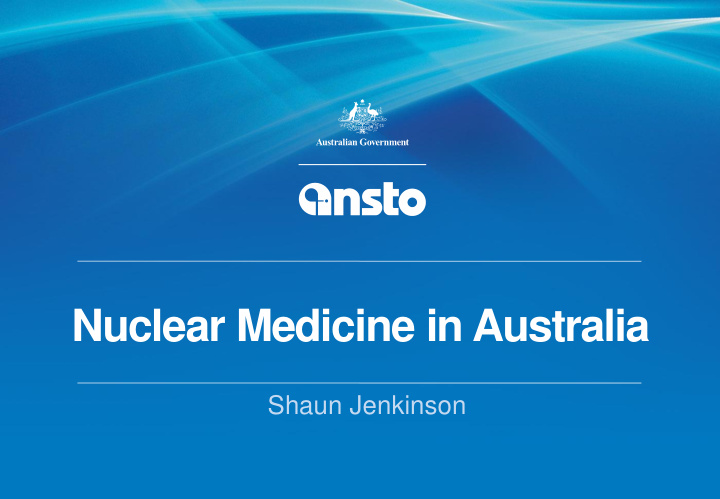



Nuclear Medicine in Australia Shaun Jenkinson
Landmark Infrastructure for Australian Science Camperdown Cyclotron OPAL Research Reactor Australian Synchrotron Bragg Institute Centre for Accelerator Science Other Science Facilities
OPAL Research Reactor 20MW Open Pool Australian Light water reactor Replaced the 10MW HIFAR research reactor (1958 - 2007) Reached criticality in August 2006 Low enriched fuel Safe and productive operation for 8 years
OPAL – Multipurpose Reactor Radioisotope production Neutron science research Silicon irradiation
Neutron Instruments at OPAL
Radioisotope Production 2 million doses of nuclear medicine are manufactured each year at ANSTO
Ionising Radiation in Medicine Radon progeny 0.2 mSv 9% Cosmic rays Medical 0.3 mSv diagnostic 13% 0.8 mSv 35% 26% 9% Terrestrial 0.6 mSv 8% Potassium-40 in the body 0.2 mSv Uranium / Thorium in the body 0.2 mSv Australian annual per capita radiation dose from natural and medical sources Source: ARPANSA
Diagnostic Imaging
Monitoring Treatment
Therapy
Comparison of Radiotherapy Treatments
Interventional Procedures
Nuclear Medicine scans Type of Diagnostic Scan Used for Bone scan Bone pain, musculo-skeletal problems, metastatic cancer (lung, breast, prostate, etc) Lung scan Blood clots in lungs, lung function Individual kidney function, obstruction, post-transplant function of implanted Renal scan organ Thyroid scan Goitre, thyroid function (hypo- & hyper-), thyroid cancer Measure transit of food through stomach – gastric motility disorders Gastric emptying Mostly staging cancer – lung, colon, brain, head and neck, uro-gynae, PET FDG scan lymphoma Detecting compromises in blood flow (perfusion) at rest and during exercise Myocardial perfusion scan Measure liver function – bile duct obstruction? Hepatic failure? Liver scan Adrenal scan Distinguish between hyperactive adrenal gland(s) and functioning tumour Assess function of tumours of neuro-endocrine origin PET DOTATATE scan Measure pumping ability of heart – often compromised by some Cardiac funtion chemotherapy (eg Herceptin)
Why do we need different radiopharmaceuticals?
ANSTO produces the different medical isotope products that are needed for different indications Product Indication Bulk export to other countries for production of Technetium generators Mo-99 Organ imaging of the liver, lung, bone, kidney & heart Gentech /Tc-99m (Technetium generators) Treatment of hyperthyroidism & thyroid cancer Sodium Iodide I-131 The relief of bone pain in patients with painful osteoblastic skeletal metastases Quadramet Sm-153 The determination of GFR rate (renal function) Chromium Cr-51 NEW Treatment of neuroendocrine tumours Lutetium-177 Scans for Hodgkin’s Disease, lymphomas and bronchogenic carcinoma. Gallium: Ga-67 Acute infections Scans for neuroendocrine tumours – diagnosis, staging and monitoring of therapy Gallium: Ga-68 Detection, staging and follow-up of neuroblastomas. mIBG I-123 Myocardial perfusion imaging Thallium Tl-201 Diagnosis, staging and monitoring of cancer treatment 18 F-FDG
Supply chain OPAL Reactor Processing Plant Global Local distribution Hospital and Clinical Imaging Health Outcomes (ANM) distribution of finished goods Pharmacy LEU U 235 targets Mo-99 separated Bulk Mo-99 Tc-99m Generators Tc-99m eluted Product Imaging helps irradiated in OPAL and purified Shipped to meet dispensed and and combined administered diagnosis & leads global demand transported with cold kits to patients for to appropriate imaging treatments 7-12 days 1 day 1 day 1 day 5 minutes - - Challenging supply chain
World supply under threat HFR Netherlands 30% Maria Poland 5% NRU OSIRIS BR-2 Canada 40% France Belgium 10-15% 10-15% SAFARI ANSTO South Africa Australia 10-15% < 5%
ANSTO’s Nuclear Medicine Project Australian Government investment of The Australian Nuclear Medicine $168.8 M was announced in 2012 Facility will supply Mo-99 to Australian and global communities
What are Neuroendocrine Tumours (NETs)? Relatively rare tumours that arise from Many are clinically silent or have non- the diffuse neuroendocrine system specific symptoms, leading to delayed diagnosis Patients often have tumours that are Therefore majority of patients present with metastatic disease (>60 – 80%) indolent and progress slowly over several years. Small� intes ne� Rectum� Appendix� Colon� Stomach� Pancreas�
So how well does it work? Baseline FDG PET Post-Lu-177 octreotate 2 years later
So how well does it work? post chemo mid-LuTate +3 months baseline Serial FDG PET/CT
ANSTO will be producing Lu-177 from the middle of 2014
Refractory Neuroblastoma Surface rendered CT +DOTATATE (GaTate) Prior multiple lines of chemotherapy (NBL06/TVD) , phase 1 trial (hedge-hog inhibitor) , MIBG Progressing rapidly Courtesy Dr Michael Hofman, Peter Mac
Response to Lu-177 + temozolomide 2 months post Baseline LuTate + temozolomide Returned to school Courtesy Dr Michael Hofman, Peter Mac
Response to Lu-177 + temozolomide Baseline Post PRRT Sustained response with 18 months follow-up Courtesy Dr Michael Hofman, Peter Mac
Thank you
Recommend
More recommend